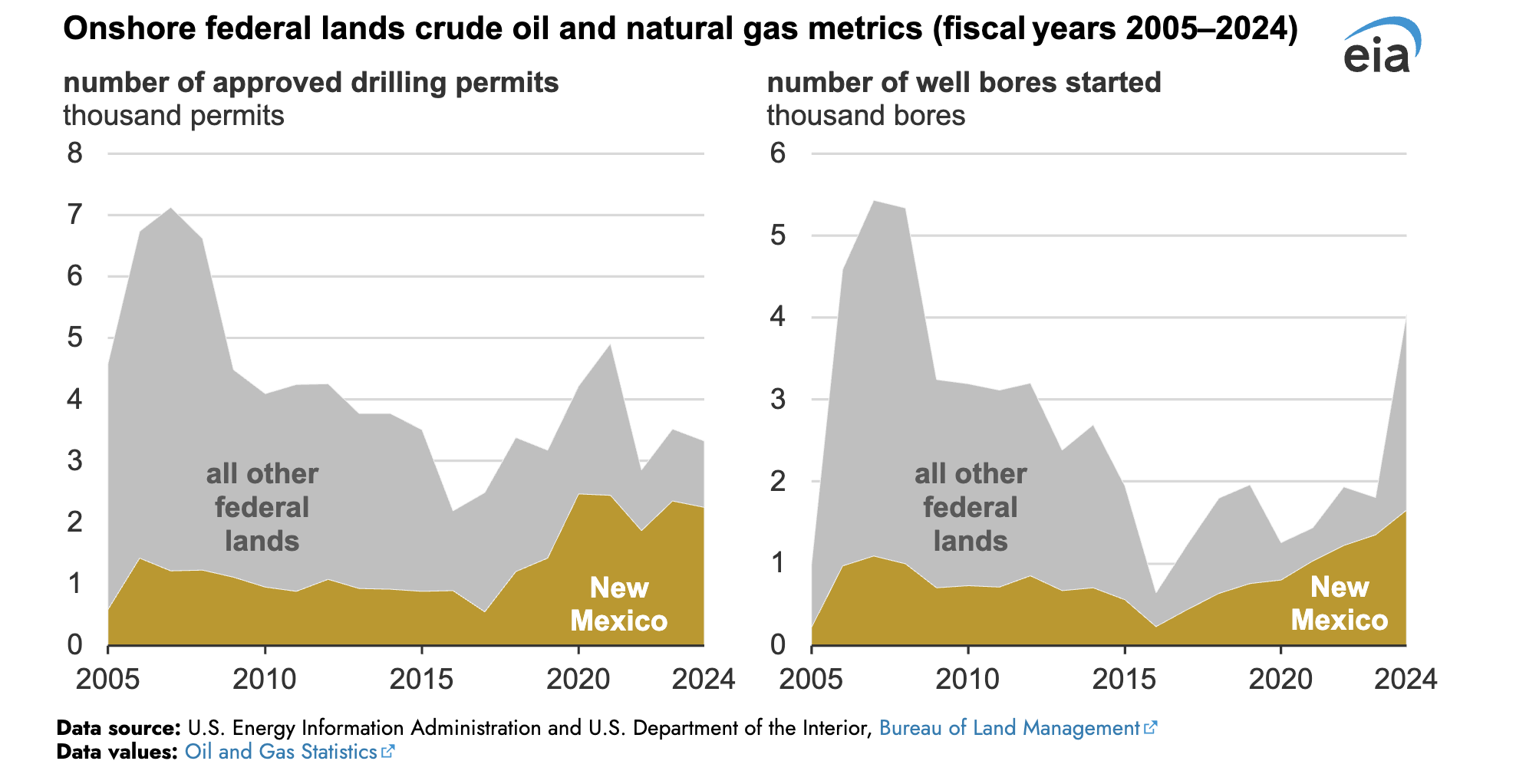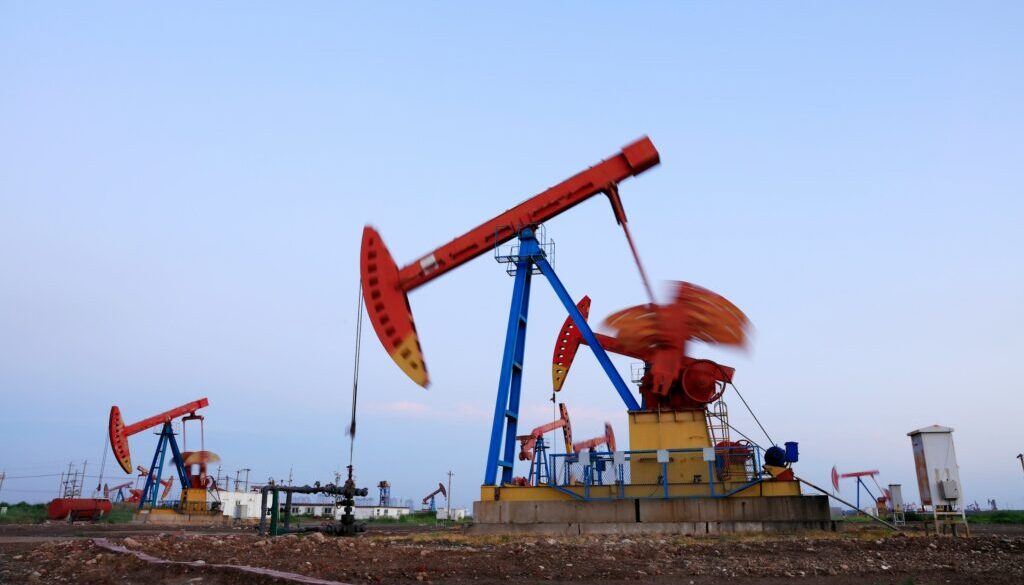Listen to the audio version of this article (generated by AI).
Crude oil production on federal lands in the US is at a record high, increasing sixfold over the past 15 years, according to a new report from the US Energy Information Administration (EIA).
The production follows a broader trend seen in total US oil production — including onshore and offshore federal lands as well as private lands — which has tripled over the same time period.
Monday’s report showed oil generated from federal lands reached 1.7 million barrels per day in 2024, representing roughly 13% of all oil produced — up from a 5% share in 2010.

The EIA, which used data from the US Department of the Interior’s (DOI) Office of Natural Resources Revenue, attributed most of the spike to drilling in the highly productive Permian Basin, located in West Texas and southeastern New Mexico. The area has accounted for the majority of drilling permits and new wells on federal lands over the past few years.
The record high production of oil on federal lands was not the only record high last year — 2024 was the warmest year since global records started, according to the National Oceanic and Atmospheric Administration (NOAA).
The 10 warmest years on record have occurred over the past decade. Burning fossil fuels for electricity, transportation and to power manufacturing is the major cause of this global warming, with fossil fuels accounting for over 75% of global greenhouse gas emissions.
Despite the evidence of worsening climate change, the Trump administration continues to push the advancement of fossil fuels such as oil, natural gas and coal, and seeks to remove any barriers to production and use. In a March press conference announcing 31 regulatory rollbacks, US Environmental Protection Agency (EPA) administrator Lee Zeldin said, “we are driving a dagger straight into the heart of the climate change religion to drive down cost of living for American families.”
But lower prices per barrel, dwindling returns on wells and economic uncertainty have analysts predicting these record highs won’t last.
Permian Basin spike
Activity within the Permian Basin is largely responsible for the recent increased oil production, making Texas and New Mexico the number one and number two oil-producing states, respectively. The New Mexico portion of the Basin doubled its output from 0.9 million barrels per day to 2 million barrels per day over the past five years, with roughly two-thirds of the oil coming from federal lands. Roughly 30% of New Mexico’s land is federally owned.
“The Permian Basin is a geologic miracle,” Christopher Kulander, a law professor at the University of Texas School of Law, said. “Oil and gas are found in sedimentary rock and the Permian Basin has not one, not two, not three, not four, not five, but in some places six productive formations, one on top of the other.”
The region also has extensive pipeline infrastructure in place to allow for growth, he added. “Good oil men know the logistics of getting their product to market.”

Brandon Myers, head of research at Novi Labs, which provides oil and gas data analytics, said the north part of the Basin, heading into New Mexico, is shallower with less silt and shale. “The stuff to the north is easier to get oil and gas out of. The south may have more oil in place, but it’s harder to get.”
But even the Permian might be headed for a downturn. “Rigs are down … you can’t grow the Permian,” Myers added.
“Uncertainty in the current market”
The new report was released as crude oil prices surged, jumping $1.72 (or 2.64%), to $66.88 per barrel. However, Novi is forecasting that oil production will start to decline in the next 12 months, Myers said. The most recent Dallas Fed Energy Survey released this month found oil and gas activity declined for a second consecutive quarter. The survey found energy executives remain uncertain and frustrated due to volatile markets and policy shifts.
A Novi analysis of the survey concluded: “the uncertainty in the current market continues to cloud decision-making in the second quarter … operators big and small are now scaling back activity and bracing for the potential for continued volatility and headwinds.” Surveyed energy executives cited low prices per barrel, instability in the Middle East and the ongoing whiplash around US tariff policies as causes for decreased activity.
The EIA in May also predicted decreased oil consumption around the world, which could hamper production over the coming years.
Federal policies
The Trump administration has made fossil fuel production and use a central theme of its legislative and deregulatory agenda. Just last week it was reported the EPA is drafting a plan that would revoke its authority to fight climate change by declaring that greenhouse gas emissions do not endanger people. In addition, the “One Big Beautiful Bill” passed by Congress will significantly impact US energy production, favoring fossil fuel production in what the administration has referred to as “energy dominance.” It phases out a number of renewable tax credits, reduces the royalty rate for oil leases and eliminates interest fees on leased land, among other measures.
However, experts say shifting political winds have less impact on oil production than most people think. “Republicans want to say that energy prices are coming down, which is good for consumers and bad for producers,” Brett Sinclair, a principal analyst at Novi Labs, said. “Democrats often want to restrict supply, which has the effect of pushing up prices and growth.”
“Republicans want to say that energy prices are coming down, which is good for consumers and bad for producers. Democrats often want to restrict supply, which has the effect of pushing up prices and growth.” -Brett Sinclair, Novi Labs
Valerie Thomas, the Anderson-Interface chair of natural systems and professor at Georgia Tech University, said both Democrats and Republicans have contributed to the spike over the past decade.
During the first Trump administration, numerous oil and gas leases were granted, Thomas said, while during the Biden administration, numerous permits were issued to the holders of those leases, allowing production of oil and natural gas.
“All of the recent US presidents [going back to President Obama] have left office with US oil production higher than when they entered office,” she said.
Featured image by Getty Images/Unsplash +



